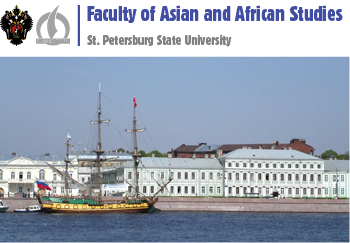Hagia Sophia and the ‘grandfather’ of Stonehenge: three exhibitions on Turkish culture are held at St Petersburg University
Three exhibitions dedicated to the cultural heritage of Turkey opened at St Petersburg University as part of the VIII St Petersburg International Cultural Forum. More than two dozen photographs of historical monuments of Turkey and over 150 books are on display in the corridor of the Twelve Collegia biulding.
The first exhibition, ‘Göbekli Tepe,’ presents a collection of photographs of the artefacts discovered during excavations of the eponymous temple complex. It is located in Eastern Turkey, in the Southeastern Anatolia region, near the city of Şanlıurfa. The complex dates to at least the 9th millennium BC and is one of the oldest and largest megalithic structures in the world. For comparison, the oldest Egyptian pyramids are attributed to the 3rd millennium BC, while the British Stonehenge is believed to have been constructed between the 4th and the 3rd millennia. The presence of Göbekli Tepe on the territory of Asia Minor enables experts to call this region the cradle of world civilisations.
The second exhibition, ‘UNESCO World Heritage Sites in Turkey,’ presents photographs of 18 iconic cultural sites of Turkey. These are architectural monuments of different eras, included in the list of UNESCO World Heritage Sites, which have long become prominent landmarks of this country. The exposition gives details about cultural and natural sites of outstanding universal value: the Great Mosque and the medieval Darush-Shifa hospital in the city of Divriği; the landscapes of the Göreme National Park in Cappadocia; the salt terraces of Pamukkale; Mount Nemrut; and the historic areas of Istanbul, Safranbolu, Ephesus, and Troy.
The theme of the third exhibition is ‘Russian translations of Turkish literature’. Visitors will see a retrospective of translations of Turkish literature into Russian from the middle of the 20th century to the present day. The exposition encompasses 150 books provided by the Turkish side. The books are translated and published as part of the TEDA programme – Translation and Publication Grant Programme funded by the Ministry of Culture and Tourism of the Republic of Turkey. The exhibition also features publications from the book collections of the M. Gorky Scientific Library of St Petersburg University.
The opening ceremony of the exhibitions has been attended by the Deputy Minister of Culture and Tourism of the Republic of Turkey, Ms Özgül Özkan Yavuz, and the Rector of St Petersburg University, Nikolay Kropachev.
It is noteworthy that 2019 was declared a cross year of Turkey–Russia culture and tourism. This was by decision of the President of the Republic of Turkey and the President of the Russian Federation. This year, the Republic of Turkey has prepared a special programme for the Cultural Forum. Apart from the exhibitions, it included discussions, some of which were held at the University. Thus, on 14 November, St Petersburg University hosted the first event of the Turkish special programme – the conference ‘Istanbul in Turkish and Russian literature’. The conference was dedicated to the discussion of the issues of civilisational ‘kinship’ between Russian and Turkish literature. The imperial past and culture unite our countries – Russia and Turkey – heirs of the great Byzantium, both situated between the West and the East. The conference brought together leading experts in Turkish and Russian literature. Turkey was represented by the famous writer and historian İskender Pala, professor at Istanbul University of Culture, and by Hüseyin Kandemir, the author of numerous historical best-selling novels and the Head of the Department of Russian Language and Literature at Selçuk University. Russia was represented by Ilya Boyashov, historian and writer whose books have been translated into dozens of languages (including Turkish), and by Apollinariia Avrutina, translator of Turkish literature and the Director of the Centre for Contemporary Turkish Studies at St Petersburg University.
On 14 November, the ‘Göbekli Tepe’ conference was held at St Petersburg University, preceding the panel discussion of the same name. The key conference participants included: the Director of the Şanlıurfa Museum, Professor Celal Uludağ; archaeologist, professor at Istanbul University Necmi Karul; professor of St Petersburg University, Head of the Department of History of the Middle East Countries Nikolay Diakov and professor of St Petersburg University, Head of the Department of Historical Regional Studies Iurii Krivosheev. The experts have discussed global aspects in the history of Anatolian civilisations.
The panel discussion ‘Göbekli Tepe’ took place on 15 November at the main venue of the Forum – the General Staff Building of the State Hermitage. The discussion reflected on the global civilisational aspects of the cultures of Asia Minor in historical and contemporary perspectives using the example of the famous archaeological site, namely the Göbekli Tepe temple complex. The key speakers included: the Director of the Şanlıurfa Museum, Professor Celal Uludağ; archaeologist, professor of Istanbul University Necmi Karul; assistant professor at the Department of Interdisciplinary Studies and Practices in Artsof St Petersburg University, Candidate of Art Studies Gleb Ershov; and turkologist, the Director of the Centre for Contemporary Turkish Studies at St Petersburg University Apollinariia Avrutina. Unique video materials of the excavations at Göbekli Tepe were demonstrated during the discussion.
- Category: News
- Hits: 1100





